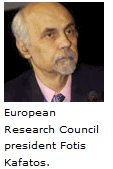|
|
|
|
|
|
|
News & Views item - April 2009 |
![]() European
Research Council Update. (April 7, 2009)
European
Research Council Update. (April 7, 2009)
In November 2002, European research ministers called on Member States and the
European Commission to discuss the purpose and scope of a Europe-wide research
council. In 2003, a Report from the European Research Council (ERC) Expert Group (ERCEG) described how the ERC might
take shape. Then in 2005 the European Commission proposed the establishment and
operation of an autonomous ERC through the 'Ideas Programme' of the Seventh
Framework Programme (2007-2013) and on 12 December 2005, the Chairman (now
president), Fotis Kafatos, and two Vice-Chairs, Helga Nowotny and
Daniel Estève, of the ERC were elected.
European Research Council (ERC) Expert Group (ERCEG) described how the ERC might
take shape. Then in 2005 the European Commission proposed the establishment and
operation of an autonomous ERC through the 'Ideas Programme' of the Seventh
Framework Programme (2007-2013) and on 12 December 2005, the Chairman (now
president), Fotis Kafatos, and two Vice-Chairs, Helga Nowotny and
Daniel Estève, of the ERC were elected.
On 18 December 2006, following its adoption by the European Parliament, the ERC and its seven-year €7.5 billion budget got the seal of approval and on 27/28 February 2007, the European Research Council was officially launched.
The "start-up phase" of the ERC is now considered completed and what has become Europe’s leading agency for fundamental research is now, according to Professor Kafatos, ready to ramp up the pace of its grants, and he believes that the economic crisis makes such investments more timely than ever.
It’s precisely at times of financial crisis that we need a counter-cyclical investment in research and development. You must make sure that the complex of our educational and research institutions is not starved in a period of economic crisis. Saving rather than investing now is a dangerous short-termist attitude. It is now that we must invest with conviction in the knowledge triangle: education, research, innovation.
According to Richard Hudson, writing in Science Business the ERC selected in its first phase: "about 575 researchers across Europe to get a total of €850 million – out of more than 11,000 applicants. Now the annual spending pace is set to jump, to €775 million this year, €1.1 billion next year, €1.3 billion in 2011, €1.6 billion in 2012 and €1.7 billion in 2013. And if Kafatos has his way, the growth won’t stop there."
And Professor Kafatos says: "By 2013 we will be at €1.7 billion – and by that year we should have a second steep increase so that we would reach something comparable to the NIH budget during the following seven years," and that's thinking big, seeing as the US National Institutes of Health's budget is currently US$30.3 ( €22.6) billion. The US National Science Foundation (NSF), which funds fields similar to the ERC, will spend $US7 (€5.2) billion in the coming fiscal year.
What may well serve as a reality check for Professor Kafatos is that on February 24 the EC announced the formation of a committee of leading experts in science policy, from both Europe and overseas, to start reviewing the work of the ERC to date.
The ERC arranges continent-wide competitions for grants, judged by independent panels of leading experts from across the world, rather than by administrators. On its first call for grants, in 2007, the ERC was flooded with applicants. With its budget already fixed that year only 3% of applicants received grants. Professor Kafatos admitted that the "process didn’t work so well," the first time around but, "This was to be expected, just about everyone would take a chance to apply when you launch something as ambitious as this, as funding of research is so tight in much of Europe. For example, it is well known that Italy does not fund research adequately, so it was not surprising that one third of the applicants to the first call were Italians. The community needs education. It needs to learn what it’s all about. And the numbers of applications are slowly drifting downwards to what we hoped, because our objective is not to fund everyone in Europe who wants to do research. We are an excellence initiative."
He then told Mr Hudson that he was pleasantly surprised that many national funding agencies in Europe gave grants to ERC runners-up: those who had met the quality criterion but could not be funded for lack of an adequate ERC budget. This was done by French, Italian, Spanish, Swiss, Swedish and Flemish research agencies.
Professor Kafatos now wants to attract applicants from outside Europe, who will come to Europe to undertake the research for which the grant is awarded. First priority, he said, is to attract US scientists – but Japan, China and India are also on the agenda.
And the ERC grants "are open to people based in industry applying for grants. No one has so far [applied], probably because it is not widely enough known as yet [that industrial researchers can apply.] We intend to make it clear that we can give grants to innovative people in industry, provided the enterprise allows the principal investigators to follow their nose in research. Basic research in industry is a component of industrial research, that falls within the ERC’s remit; we would be very happy to support."
The ERC president concluded saying that a further funding increase, from 2014, is needed to consolidate the attractiveness of ERC grants and strengthen European research: "You need Europe to clearly succeed in this major undertaking. Any stalling would be misguided. In a moment of crisis you want to put resources as much as possible to those who will have a major impact. Excellence is at the core of the ERC."
He then added his tag line: "If you think excellence is costly, try mediocrity."